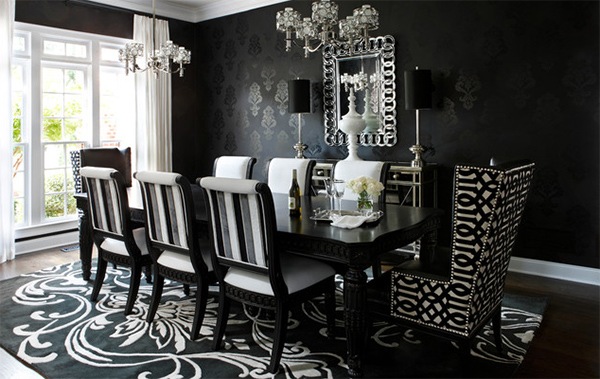If you’re contemplating redesigning your dining room, taking advantage of Feng Shui principles can be a game-changing strategy for enhancing the comfort and inviting quality of the space.
As an area associated with aspects of life such as family, celebration and abundance, the dining room requires special attention. It serves as a communal space where nutrition transcends the physical act of eating, extending to meaningful interactions with family and friends.
One of the simplest yet most profound ways to incorporate Feng Shui into your dining room is through intentional color choice. The psychological influence of color is undeniable; it has the ability to change mood, influence perception and manipulate the overall energy of a room. Feng Shui goes beyond this, categorizing colors based on their elemental associations and their positions on the Feng Shui Bagua map, a tool that provides insight into different areas of life.
Therefore, applying Feng Shui color theory allows you to create a dining room space that is not only visually attractive but also energetically harmonious. You don’t have to paint the entire wall to energize a particular color. Versatility exists in expressing these color energies through furniture, artwork or other decorations.
Feng Shui principles for selecting dining room wall colors
In selecting dining room wall colors, you should focus on the five-element theory, which posits that colors are categorized into elements: water, wood, fire, earth and metal.
The dining room, traditionally a place for gathering and sustenance, is best suited to earth and wood elements. Therefore, consider colors like beige, light yellow, or pale green for the walls. These hues foster a warm, welcoming atmosphere conducive to conversation and connection.
You must also consider the directional orientation of the dining room. For instance, if the room faces south, warmer colors like red or orange can be auspicious; whereas, a northern orientation may benefit from cooler colors such as blues or greens. The aim is to achieve balance between the room’s inherent qualities and the selected wall color.
Additionally, pay heed to the interaction between color and other Feng Shui factors like natural light, shapes, and furniture arrangement. Soft, light colors generally enhance a room’s natural light and give an expansive feel. On the other hand, darker colors may confine the space but can add depth and sophistication when applied thoughtfully. Always aim for cohesiveness when combining these elements; discord can disrupt the intended flow of positive energy.
The best Feng Shui colors for your dining room
As LotusBuddhas shared, optimizing your dining room involves more than just furniture arrangement; it requires thoughtful color selection that aligns with specific elemental energies. These color choices significantly affect the room’s ambiance, potentially enhancing your overall dining experience.
Brown, beige, or pale yellow
Brown, an embodiment of the earth element, imparts a stable, grounding energy ideal for dining spaces. You can incorporate this hue by selecting warm-stained wood finishes for your dining table and chairs. Additionally, subtle touches like brown pottery or planters can bring in that steady earth energy without overwhelming the room’s visual composition.
Green
Green, linked to the wood element, imbues your dining room with revitalizing, fresh energy. You could paint the walls in shades of green that evoke the lushness of spring or opt for an area rug with green motifs, simulating the feeling of standing on a verdant patch of grass. The inclusion of houseplants or vases with fresh greens can further amplify this life-affirming energy.
Blue
Blue, especially mid-tone blues and blue-greens, align with the wood element as well. These shades can bring a calming, familial atmosphere to your dining room. You might choose to paint the walls a vibrant teal or add blue upholstered chairs to foster a sense of growth and unity.
Red
Red, though vibrant, is another color you may consider. Connected to the fire element, reds and burgundies can invigorate the space with warmth and stimulating energy. While an entire wall in red may overwhelm, smaller accents like table runners or centerpieces can offer a balanced touch of this passionate hue.
Therefore, you should consider choosing colors thoughtfully to establish a dining environment that is consistent with Feng Shui principles, enhancing not only the visual but also the energetic harmony of the space. Think of these guidelines as an effective roadmap to creating a dining room that nourishes both body and soul.
Feng shui colors you should avoid in the dining room
In applying Feng Shui principles to your dining room, the avoidance of certain colors is as crucial as the incorporation of auspicious ones. Certain hues, although aesthetically pleasing, may counteract the intended energies for a dining space, leading to an imbalance in elemental harmony.
Blacks and dark grays
You should generally avoid blacks and dark grays, as they are connected with the water element. In Feng Shui, water symbolizes flow and movement, not qualities conducive to the stable, grounding energy desired in a dining room. These dark colors can create a sense of heaviness or stagnation, rather than promoting flow and conversation.
Whites and light grays
Whites and light grays, though neutral, are associated with the metal element, which fosters an atmosphere of focus and finality. Such energies are not ideal for a dining room where you aim to encourage lingering conversations and a relaxed mealtime. Although these colors may appear modern and sleek, their energetic properties may disrupt the desired social dynamics.
Neon colors
Lastly, excessively vibrant, neon colors should be exercised with caution. While colors like neon green or electric blue may seem exciting, they can agitate the energy in the room, potentially leading to increased stress levels and a less comfortable dining experience.
However, if you find that these colors resonate with your personal aesthetic, you can still incorporate them in minor accents or decor items, ensuring they don’t dominate the space. The key is to balance them with earthier tones or wood elements that align more closely with the desired Feng Shui energies for a dining room.
In summary, the judicious selection of colors based on Feng Shui principles is not merely an aesthetic endeavor but a strategic approach to elevate the overall dining experience. With the dining room serving as a fulcrum for family gatherings, social celebrations, and the nurturing of body and soul, the significance of color cannot be overstated. Even if you choose to deviate from these core colors, understanding their elemental affiliations empowers you to balance them effectively, ensuring that your dining space remains a haven of harmony and positive energy.








